6 January 2014
I mentioned in my 2013 recap post that we had recently ticked off the major financial goal of paying off my student loans. HOORAY! I received a few emails asking questions about how we did this, so I thought it would be a perfect topic for our first Marvelous Money post of the new year!
Let me make the requisite disclaimer here that this is simply me sharing my experience. I’m also assuming that you’re starting from a place of paying all of your bills on time. Debt can be complicated and scary, so if you’re in over your head, I would highly recommend seeking the advice of a financial professional.
I wanted to start by briefly addressing why paying off debt is a worthy goal. With it being the New Year, a lot of people are talking about this right now (which is awesome!), but if paying off debt is just something that sounds good, it’s easy to lose heart when you’re slogging through the often long and tedious process. There’s power in understanding the why. Remember that aside from reducing the amount you’ll spend in interest over your lifetime, the real goal of paying off debt is to move one step closer to financial freedom — and when you’re financially free, you have more independence, more security, and more options in almost every part of your life.
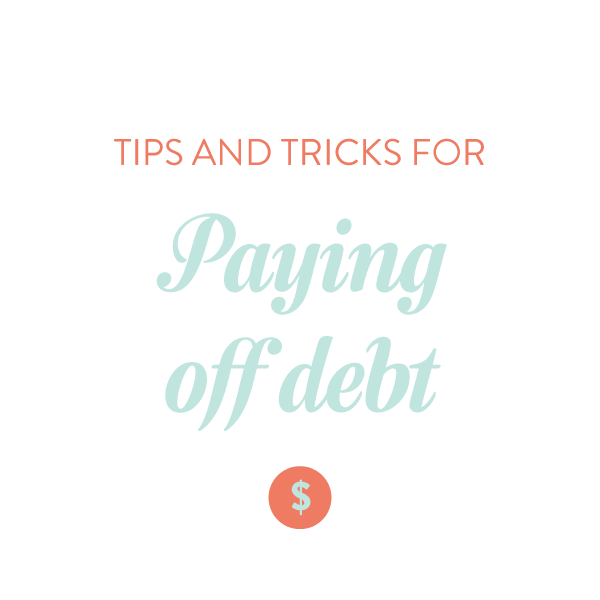
Let’s begin! I’m going to start with a little background on our situation, and then share a few techniques we’ve used over the last four years. From the beginning of 2010 (shortly after we graduated) we’ve had five financial goals. We tackled them roughly in this order, though all have been ongoing:
1. Fully funding our emergency fund
2. Fully funding our wedding contribution
3. Fully funding a house down payment
4. Paying off my student loans (3)
5. Paying off our car loans (2)
We’ve never had credit card debt. Our focus (and dollars) have shifted over time, but here’s a rough breakdown from year to year:
2010: Extra money went toward wedding and emergency funds (minimum payments on students loans, no car payments).
2011: Extra money went toward wedding and emergency funds (minimum payments on student loans and minimum payment on car loan number one, added halfway through the year). In the last two months we doubled the car payment.
2012: Completed wedding and emergency funds and transferred that monthly amount to a down payment fund. Added a new car payment but did not increase the total amount spent on cars by cutting back car payment number one to minimum (see 2011). Increased one of three student loan payments and paid off that loan by the end of the year.
2013: Completed down payment and transferred that monthly amount to student loans. Increased student loan amount again later in the year to pay both off.
2014: Transferred entire amount to car loans, which will both be paid off by May.

Aside from sticking to a budget, here are a few of the techniques we used:
Schedule payments in advance.
Sign up online for a monthly auto-debit for each of your accounts so that you’re never late with or forget a payment. Make it automatic – you won’t miss it as much as you think.
Feel the pinch.
Every time our budget expanded, we chose to allocate the extra dollars toward debt reduction. Raise at work? Going toward debt. Bonus? Going toward debt. EFM profits? Going toward debt. Sometimes in the last few years we looked at each other and were like, why do we feel poor?? But then we reminded ourselves that we were living at a lower standard of living by CHOICE. If you’re paying off debt and are not feeling the pinch in your lifestyle, you almost certainly have room to cut back and increase your payments.
Pay more than the minimum amount.
If you’re feeling the pinch you are likely already doing this, but it’s worth stating again: pay more than the regular monthly amount. Annoyingly, banks will often make this difficult to do (you might have to talk to a representative or mail in a form instead of doing it online), but persevere! After all, they don’t want you to stop paying them interest :) At times, we were paying more than twelve times the required monthly payment on certain debts using the debt snowball. Which leads us to…
Roll the snowball.
The debt snowball is simple, but it is by far the most important technique we used to pay off our debt early. The basic idea is to pay the minimum amount on all of your debts except one and then throw all of your other available resources at that one. Once that debt is paid, immediately move the payment for that debt toward another and so on until all of the debts are paid. You can follow the general outline of how we did this above. Dave Ramsey suggests starting with the debt with the smallest dollar amount and moving toward the largest dollar amount; other experts recommend starting with the debt with the highest interest rate and moving toward the lowest interest rate or considering the taxability. We used a combination of these strategies. As long as you’re working aggressively toward your goal, I don’t think you can go wrong.
Track your progress.
I kept a Google Doc spreadsheet that listed our debts, the current amount we paid per month on each, the outstanding total of each, and the month the last full payment was scheduled. Every time a payment processed, I’d go in and update the spreadsheet. It was extremely motivating to see everything shrink over time!
Two final thoughts:
1. Work with urgency, BUT.
I am all for paying down debt aggressively. However, as in almost every other area of my life, I believe that a dose of moderation is healthy. Throughout this process John and I have made decisions that not all experts would agree with, but that we are comfortable with because they were thoughtfully made. For example, we chose to save for our wedding instead of putting that extra money toward a debt payment. We also have taken several trips together over the last few years, money which could have gone toward paying a debt.
I hesitate to even include this because I don’t want it taken out of context or for anyone to think that you can be jetting to exotic locations every month (or even every year!) and still be making aggressive progress on your debt, but y’all are sophisticated people. Balancing on one hand the idea of “living like no one else so you can live like no one else” and on the other, the reality that life is uncertain and your days are not guaranteed, is difficult, but very necessary.
2. Think about what’s next — tell your money where to go.
As we approach the end of our debt snowball, we’ve been thinking about how we want to allocate that money once it’s available. We are still deciding, but we’re currently planning to use some of it to begin building up a car fund so that our next car purchase (hopefully a few years from now) will be in cash.
Once you find yourself in this position, by all means, go ahead and use some of that money for something fun! (And feel free to dream about it beforehand as motivation!) But remember you also have a great opportunity at this juncture, and the potential to build a firm foundation for your financial future — one where you speak about debt only in the past tense. You’ve already conditioned yourself (probably for several years) to live without a considerable amount of your take-home pay, and so instead of increasing your consumption, why not put some of it toward other financial goals? (Might I suggest retirement or an emergency fund?) The best part? This time, instead of paying interest, you’ll be gaining interest. And that, my friends, is pretty marvelous.
I would love to hear: Is paying off debt something you’re working toward? Where are you in the process? Are you using the debt snowball?
P.S. Want some more encouragement? My friend Nancy and her husband Will have an amazing story of paying off their house in 32 months. Read it in five parts: 1, 2, 3, 4, 5.
14 October 2013
One of my favorite pastors preached a great sermon yesterday on the topic of money (first in a two-part series; you can find them both here). Highly recommended! He briefly touched on retirement savings, which reminded me that I owe y’all several more posts on the same topic. I loved hearing your thoughts in the comments on our first post in this mini series, and now it’s time to get into specifics. We’re continuing with a beginner’s guide to 401ks! Let’s go with a question and answer format today.
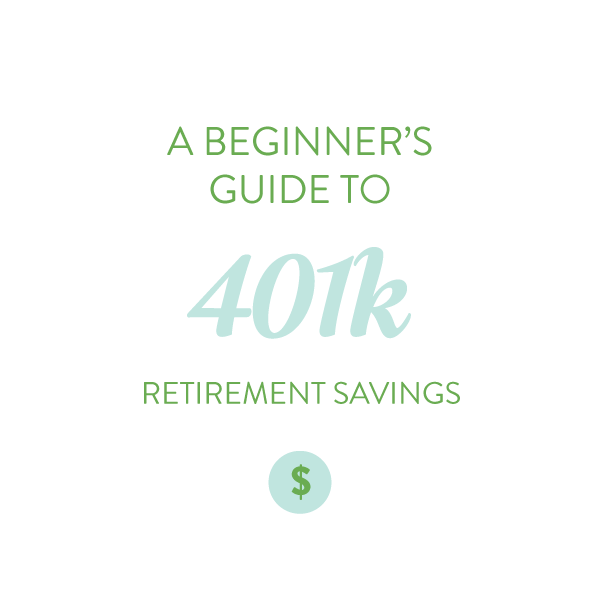
What is a 401k?
A 401k is a retirement savings account offered by some employers (usually larger ones). If your employer does not offer a 401k plan or you are self-employed, you’ll probably want to save via an IRA, which we’ll cover in a future post.
A 401k is not an investment — it’s just the type of account that holds your investments. Investment options within a 401k are determined by the employer.
What investments can I make through a 401k?
When you sign up for your 401k, you’ll be presented with a list of your investment options. Some plans will have hundreds of options, and some plans will have fewer than a dozen — it’s up to your company. All of the investment options will be mutual funds, with one possible exception: company stock. Some plans do include a feature that allows more advanced investors to expand their options to include stocks, bonds, CDs, and other investment vehicles.
What about the company stock?
I assume that you like the company you work for, and believe in what they do. (Or at least, I hope so!) So, should you invest all of your 401k in your company stock? NO! If your company offers their stock as an option, do NOT put all your money in it, for one reason: diversification. A simple and quick example of why diversification is important: if you’re riding in an elevator, would you prefer to have it suspended by one or twenty cables? Don’t put all your eggs in one basket, no matter how good you think it is. Many experts recommend investing no more than 5% of your assets in your company stock.
How much should I contribute?
For 2013, the maximum amount you can contribute is $17,500 if you’re under 50. There is no minimum. $17k sound like a lot? John and I love Megan McArdle, and she recommends saving 15% of your gross income for retirement. (Yes, even though, as she says, “When I tell people that they need to save 15% of their income, I am greeted with the same sort of disbelief that might greet a suggestion that they move to Tanzania and become big game hunters.”)
15% is so much! Help!
15% IS a lot. If it’s not feasible for you to start at that level, save at least enough to get your full company match. This is FREE MONEY. What does it look like? A common way companies will do this is to give you $1 for every dollar you save up to 3% of your pay, and then give you $.50 for every dollar you save on the next 3% of your pay (but every company is different). The end result? 10.5% of your pay is added to your retirement savings account, and you only have to contribute 6%!
How about taxes?
There are two ways to contribute to your 401k, and both have tax benefits, because the government wants you to save for retirement! Number one: Most plans let you save your money pre-tax, which means the money you’re contributing to your 401k gets deducted from your taxable income on every paycheck. Down the road, when you take the money out (in retirement), you’ll have to pay taxes on all the money. Tax benefits today, taxes when you withdraw.
Number two: An increasing number of 401k plans are offering Roth contributions, which is basically the reverse of number one: you pay your regular taxes on your contributions, and when you withdraw the money, assuming you are over 59.5 and you made your first Roth contribution at least five years earlier, there are no taxes on the withdrawal. Taxes when you contribute, no taxes when you withdraw.
Since a 401k is offered through my employer, what happens if I leave my job?
Excellent question! One of the biggest mistakes people make is to withdraw their 401k savings when they leave their job, so we’re not going to do this. Another poor option: Leaving it at the company you’re leaving. It’s harder to manage that way, and your former company might charge you fees or change your plan. Better options: “rolling over” the money to an IRA or a new 401k offered through your new employer. Remember that the money YOU contribute to a 401k is yours, as are any company contributions you’re fully vested in. (Companies usually give you the right to their contributions based on your length of service — for example, they might vest a third every year until you’re fully vested after three years.)
If you haven’t discussed your options with a representative of your company or plan before, this is a GREAT time to do so! In fact, this is a great time for me to remind you that I am neither a financial planner nor a tax adviser, and that this is a very basic guide to 401ks. Retirement savings are VITAL but can be complicated, so I highly encourage you to seek guidance along the way.
One thing that’s not complicated? STARTING! I hope this post has given you the encouragement to do just that :)
10 September 2013
I have a favorite pair of shoes. They’re from Target, and I’ve had them for about seven years now. They’re a shade in between black and brown that goes with everything, they have low heels so they’re comfortable to walk in, and they have a pointed toe that looks polished but doesn’t pinch. Perfection! Except for the fact that the heels have been completely ground down over the years, leaving only the head of a nail poking out. I’ve tried to replace them with a similar pair several times, but never found a fit or look I loved.
Eventually, it occurred to me that I might be able to have the heels replaced. I wasn’t even sure if cobblers still existed (turns out they do), and I thought that even if they did, they’d probably think I was crazy for wanting to fix a beat up pair of Target shoes, but I figured it was worth a shot. A quick search on Yelp turned up a highly-rated shop (H&H in Cameron Village, for my local peeps). I explained to the man behind the counter what I wanted, and he promised they’d be ready in three days. And they were! I picked them up the next week, and for $11.30, I had a greatly improved pair of heels. Don’t get me wrong, they’re still seven-year-old shoes, but I’m no longer embarrassed when I flash the soles, and I don’t go clickety clack whenever I walk.
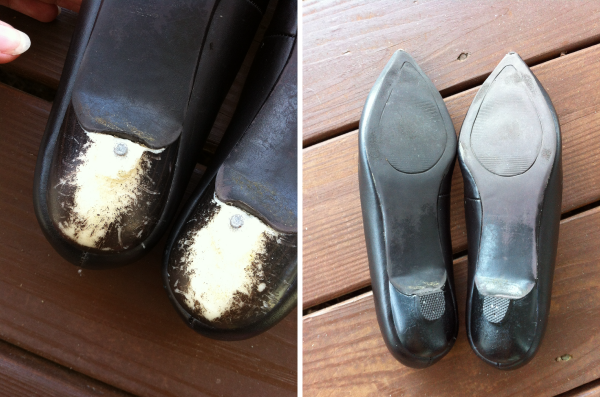
Fixing something I already own and love instead of spending time and money searching for something I might love less? That’s a major win in my book. Have y’all ever visited a cobbler? Do you have a seven-year-old pair of shoes you adore?
P.S. The next shoe adventure in store? I really want to dye my white wedding shoes black, but am clueless on where to start.
30 August 2013
Welcome back to Marvelous Money! We appear to have taken a bit of a summer hiatus, but we’ll just call that time to let the first seven posts sink in. (Missed one? You can find them all here.) So far we’ve covered emergency funds, managing joint finances, building a budget, and yes, how to spend money :) Now, it’s time to talk retirement.
Before we get into the nitty gritty, though, I thought it might be worthwhile to spend a bit of time on the WHY. Or, perhaps more importantly, the why NOW.
Because yes, everyone knows that theoretically they should be saving for retirement. But are you? I’m betting that if you see the reality of what starting now versus starting in ten years means for your future, you will indeed be motivated to take action. If you’re reading this in your twenties or thirties, you have an insane amount of power in your hand, and it’s called compound interest.

Let’s look at a few numbers. Let’s say you start saving for retirement at age 25. You put away $125 a month, and you earn an 8% average every year (around the average annual historical return of a balanced portfolio of stocks and bonds). After 40 years, at age 65, you have about $439k. Marvelous!
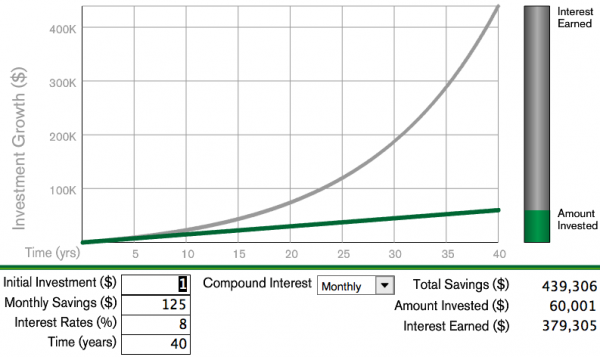
Now, let’s say you start saving $125 ten years later, at age 35, with the same return. At 65, you have about $187k.

Let’s go one step further, starting at age 45 and saving $125 a month. At 65, you’ll have just $74k. Yipes!
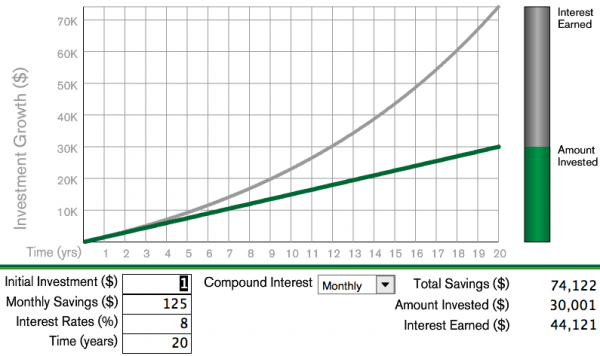
Obviously, if you start saving later in life, you’d probably save more per month — if you can. But WE want to make our money work for us, don’t we? And I don’t know about you, but I think the demands on my money are only going to grow as I get older.
To go back to our example for a moment, let’s say you start saving for retirement at age 35 but want to end up with the same amount of money at 65 as the peeps who started at 25. To start ten years later, you’d have to save MORE THAN DOUBLE the amount per month — $293 versus $125.
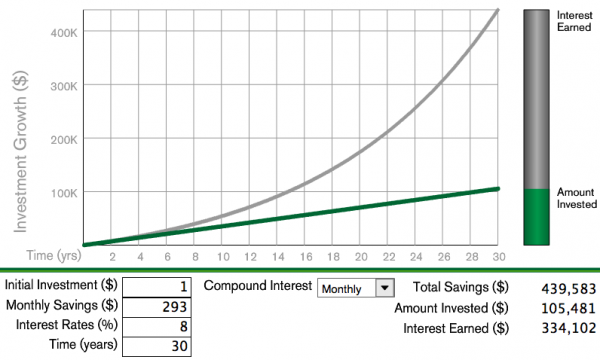
This gets at the question I pose in the title of this post: Why save for retirement? Fully funding your retirement means setting yourself up for financial independence. Not only will you have more flexibility later in life (when to retire, etc.), you’ll have more freedom throughout your life, as you need to save less money to reach the same goal.
Just one more example. Imagine you’re given two options: you can have one million dollars today, or a penny that doubles in value every day for a month. Which do you take? If you take the penny, after the first ten days you’ll have $5.12. Not too exciting. After 20 days, you’ll have $5,242.88, which is better, but still nowhere near one million. BUT WAIT, there’s more — by day 28, you’ve surpassed the first option with $1.34 million, and on day 30, you have $5,368,709.12. Marvelous, indeed!

The lesson? You can’t skip the boring part — and I guarantee saving for retirement might look boring for awhile. But the boring part? That’s your ticket to the exciting part, where your money truly starts working for you. The most growth comes at the very end.
So, here we are. You have to start. Time is the most powerful part of this equation, and it’s the ONLY part you can never make up. I know that there are lots of demands on your money, and maybe $125 a month seems like a lot right now. However, if you read this blog, I would be willing to bet that you’ve been spending $125 per month on something discretionary that you could redirect toward retirement savings. Fun? Nope, not always. But I don’t expect anyone to hand me my retirement, and I don’t think you should, either. As my Dave Ramsey friends like to say, if you will live like no one else, later you can live like no one else. And that’s the truth.
Much more to come on this topic in the coming weeks, but in the meantime, I would LOVE to hear from you. Where are you right now with retirement savings? Do you have a 401k or IRA? Do you contribute a set amount per month or year? Do you feel good about where you are? This will be super helpful as I plan future posts, so please chime in, friends!!
P.S. Since I’m asking you to share, I should, too: I opened my first IRA at age 19 (traditional) and opened a Roth a few years later. I’ve contributed a bit less than $125 per month over the last few years since we were focused on debt reduction, but the big goal for 2014 is to fully fund! More on all this soon!




























